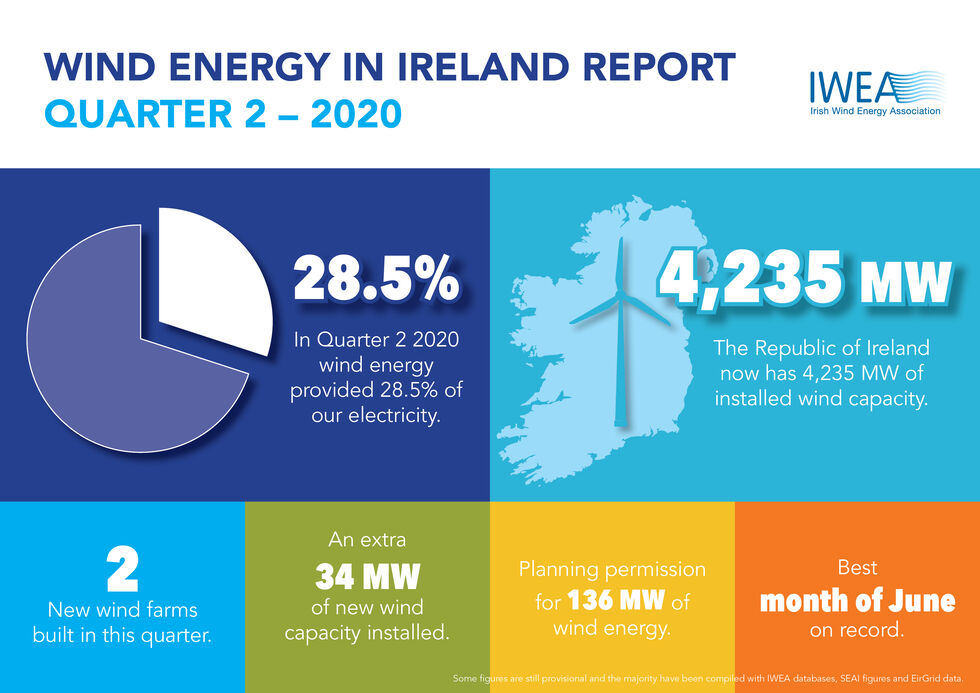Ireland on track for 2020 target after strong second quarter for wind energy
03 Aug 2020
A strong second quarter performance by Ireland’s wind energy industry means Ireland is now on track to reach our 2020 renewable energy target to source 40 per cent of our electricity from renewables.
Figures released today by the Irish Wind Energy Association show that wind provided 28.5 per cent of Ireland’s electricity across April, May and June and is at 36.8 per cent overall for the first half of the year.
Dr David Connolly, CEO of the Irish Wind Energy Association, said: “Ireland is number one in the world for the share of electricity demand met by onshore wind.
“Last year we broke records by providing a third of the country’s electricity and, along with smaller contributions from other renewables, we are now clearly on track to reach Ireland’s 40 per cent 2020 renewable electricity target.
“More wind power means less carbon emissions. It means fewer fossil fuel imports. It means more jobs and more investment in Ireland.”

The second quarter of 2020 included the best month of June on record for electricity generation. Two new wind farms were connected and planning permission was obtained for another 136 MW of wind energy.
Supreme Court decision
Last Friday’s Supreme Court decision quashing the Government’s plan to cut greenhouse gas emissions means that a new plan is needed to enable Ireland to build a zero-carbon society by 2050.
Dr Connolly continued: “Wind energy will be Ireland’s number one source of electricity in five years. As we electrify heat and transport the need to develop more renewable electricity and to do it more quickly is only going to grow more urgent.
“It is essential, if we are to play our part in the fight against climate change, that the Government prioritises reforming our planning system so we can develop wind energy off our coasts and ensures that the new Wind Energy Guidelines enable us to build the next generation of onshore wind farms.
“It is this Government that must ensure we have the right policies and the right strategies to enable industry to reach the target set out in the Climate Action Plan to provide 70 per cent of Ireland’s electricity from renewable energy by 2030 and to go even further to a decarbonised energy system.”
Stronger grid
While Q2 2020 was another successful quarter for the wind energy industry there is concern at rising levels of dispatch down – where wind farms are powered down or off as the grid tries to cope with large volumes of renewable generation.
Dr Connolly said: “EirGrid and ESB Networks are world leaders in integrating renewable electricity on Ireland’s transmission system. But with more renewable power connecting every month we must strengthen our grid to take power from new wind farms and solar farms.
“We know that EirGrid and ESBN Networks have the skills and experience, but the Government needs to ensure they have the resources and the support they need to build a transmission system fit for Ireland’s energy revolution.”
Key statistics
Wind energy’s share of electricity demand: 28.5% – up from 26.1% in Q2 2019.
Total amount of electricity generated by wind in Q2 2020: 1,844,000 MWh – down slightly from 1,874,000 MWh in Q2 2019 because of a fall in electricity demand due to Covid-19.
Total installed wind energy capacity at end of Q2 2020: 4,235 MW.
Total new capacity installed: 34 MW.
Number of new wind farms built: 2.
Number of new wind farms to get planning permission: 2 with a total capacity of 136 MW.
Amount of wind energy dispatched down in Q2 2020: 296,347 MWh
Note to Editors
The figures in the IWEA Quarterly Report are based on data provided by EirGrid, ESB Networks, the SEAI and our own members. Some figures are provisional and may change as new data comes in.
A megawatt (MW) is a unit of power. A single megawatt is equivalent to around 1,000 kilowatts. Boiling a kettle, for example, takes around two kilowatts.
A megawatt-hour (MWh) is a unit of energy. It is normally used to refer to the amount of electricity generated or consumed. A standard Irish household would use around 4.2 MWh every year.
Wind energy is ‘dispatched down’ when wind farms are instructed by EirGrid, as the system operator, to stop generating electricity.
This is typically done due to constraints on the electricity network – the transmission system is physically unable to carry more electricity from where it is being generated to where it is needed – or to ensure system stability.






